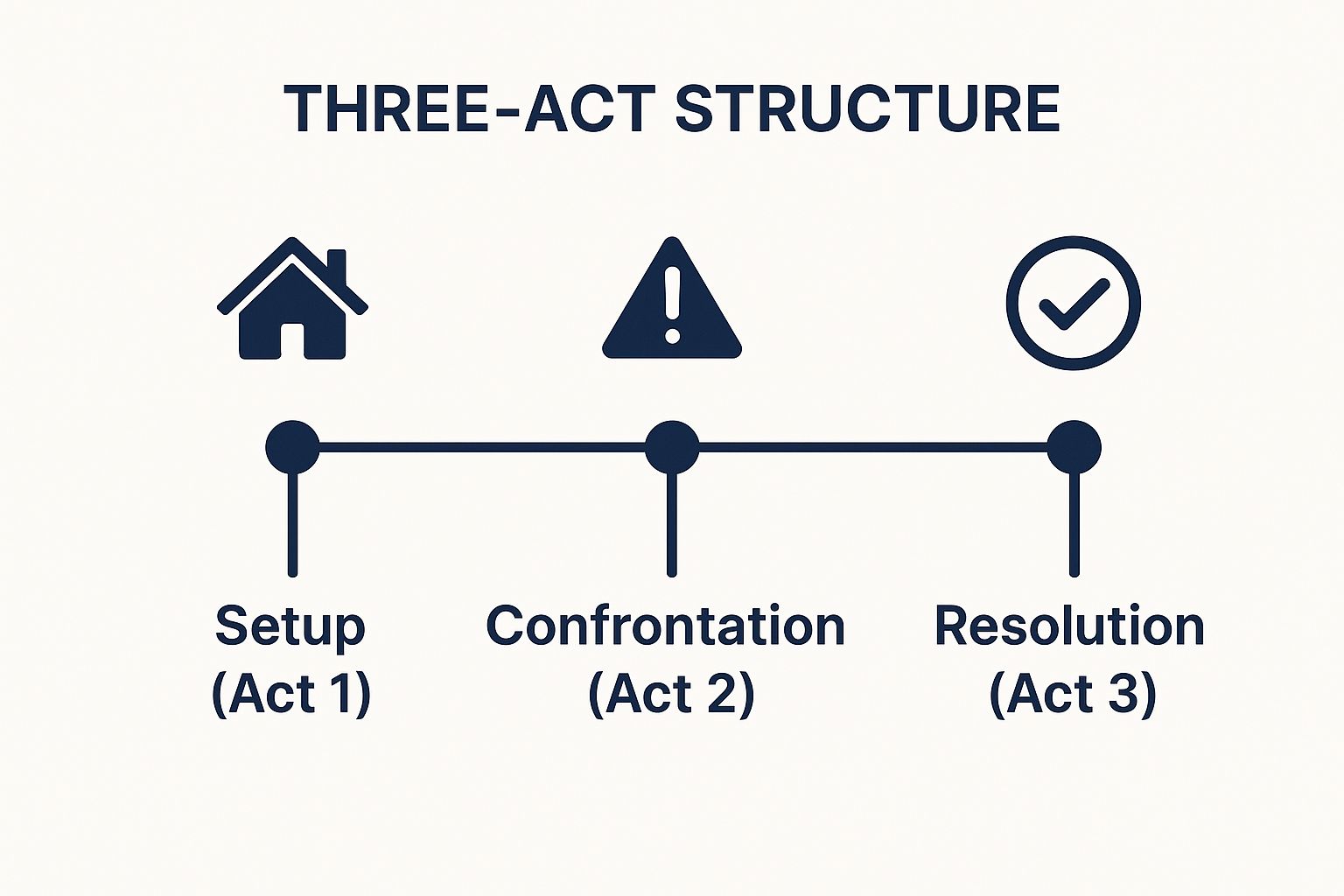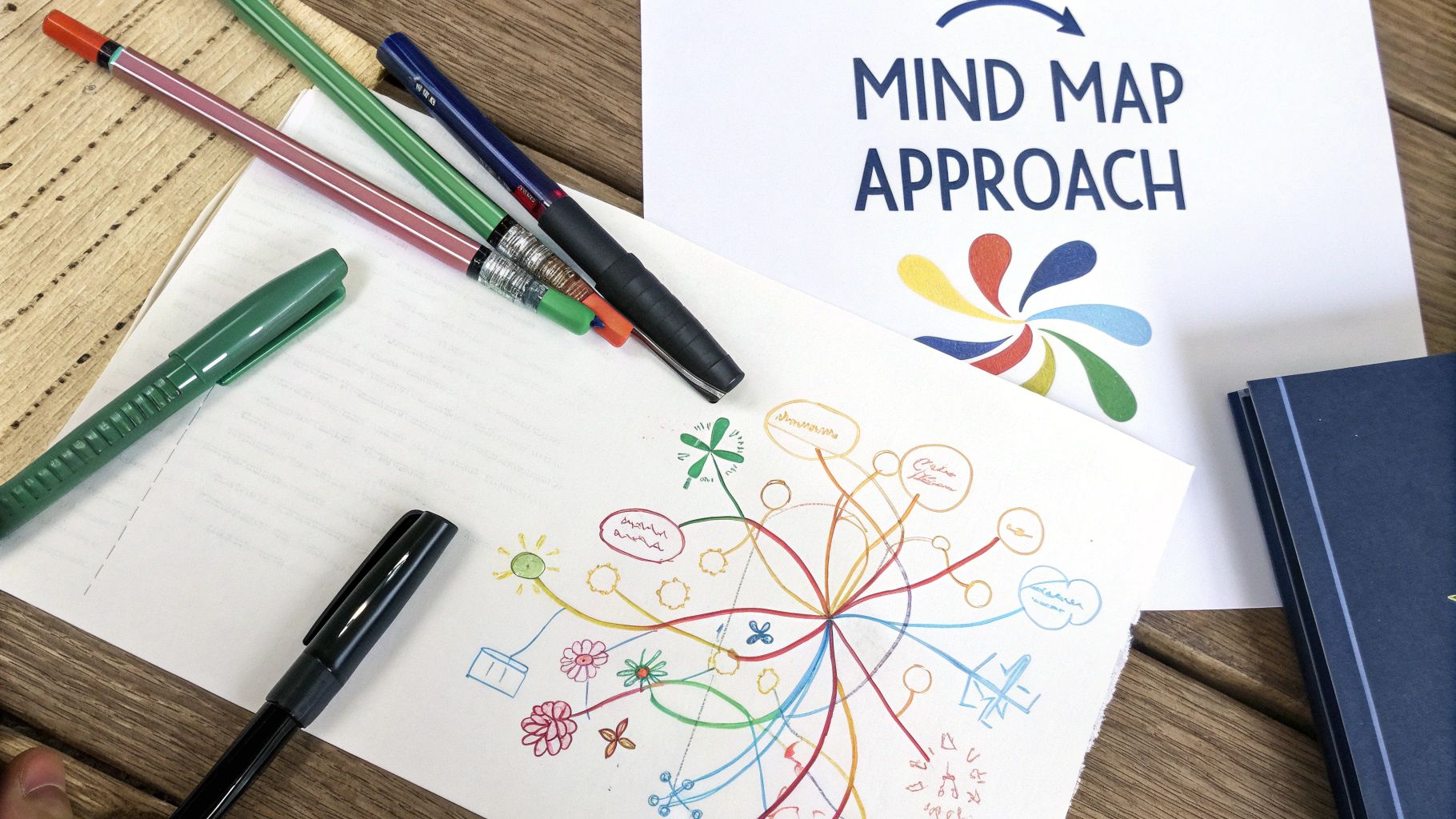Every great book begins not with a perfect first sentence, but with a solid plan. A well-crafted outline is the architectural blueprint for your story, providing the structure needed to build compelling narratives, develop memorable characters, and ensure a satisfying reader experience. Without one, you risk writing into dead ends, creating plot holes, or losing momentum halfway through your manuscript. Just as a solid outline acts as a blueprint for a book, a similar structured approach is vital for other content forms, such as using a content marketing strategy template as a blueprint for effective digital campaigns.
This guide moves beyond theory to explore seven diverse and powerful book outline examples. We'll break down the strategic purpose behind each method, from the classic Three-Act Structure to the intuitive Mind Map Approach. You'll find tactical insights for implementation and clear guidance on how to choose the right framework for your specific project. Whether you're a meticulous planner who needs every detail mapped out or a writer who thrives on discovery within a structured container, there's an outlining method here to transform your brilliant idea into a finished, polished manuscript. Let’s explore the blueprints that build great stories.
1. The Three-Act Structure
The Three-Act Structure is one of the most enduring and widely used book outline examples for storytelling. Rooted in Aristotle's Poetics, this framework divides a narrative into three distinct parts: the Setup (Act 1), the Confrontation (Act 2), and the Resolution (Act 3). It provides a reliable blueprint for building dramatic tension and creating a satisfying emotional arc for the reader.
This classic framework is the backbone of countless beloved stories, from J.K. Rowling's Harry Potter series to Gillian Flynn's Gone Girl. Its strength lies in its simplicity and its focus on a clear cause-and-effect progression, making it an ideal starting point for novelists, memoirists, and narrative non-fiction writers.
How It Works
The structure maps the protagonist's journey from their ordinary world through escalating conflict to a final, transformative conclusion. Each act serves a specific narrative function, guided by key turning points that propel the story forward.
The timeline below visualizes the core progression of this foundational narrative framework.

The infographic highlights how each act builds upon the last, creating a steady and compelling narrative momentum.
Actionable Tips for Implementation
To effectively use this structure, focus on the pivotal moments that define each act.
- Act 1: The Setup introduces the protagonist, their world, and the central conflict via an inciting incident. This act ends when the protagonist makes a choice that pushes them into the main conflict.
- Act 2: The Confrontation is the longest part, where the protagonist faces escalating obstacles and the stakes are raised. A significant midpoint often shifts the character's goal or understanding.
- Act 3: The Resolution begins after the lowest point, leading to the climax where the central conflict is confronted and resolved, followed by the story's conclusion.
This model provides a clear map for both plot and character development, ensuring your story remains focused and engaging. For a deeper dive into this and other foundational frameworks, you can learn more about narrative structure on barkerbooks.com.
2. The Hero's Journey (Monomyth)
The Hero's Journey, also known as the Monomyth, is one of the most resonant and powerful book outline examples for crafting transformative character arcs. Popularized by mythologist Joseph Campbell, this structure details an archetypal adventure where a hero ventures from their ordinary world into a realm of supernatural wonder, faces trials and triumphs, and returns home changed.

This narrative pattern is the structural DNA for countless myths, legends, and modern blockbusters, from George Lucas's Star Wars saga to J.R.R. Tolkien's The Lord of the Rings. Its universal appeal lies in its focus on the protagonist’s internal growth alongside their external quest, making it a perfect framework for epic fantasy, adventure, and even introspective memoirs like Elizabeth Gilbert's Eat, Pray, Love.
How It Works
The Hero's Journey typically consists of 12 to 17 distinct stages, which are often grouped into three main phases: Departure, Initiation, and Return. This framework maps a circular path that begins and ends in the hero's home but leaves them fundamentally transformed by their experiences. The journey is not just about defeating a villain but about the hero overcoming internal flaws and gaining wisdom.
While the full 17-stage model from Campbell's The Hero with a Thousand Faces is comprehensive, many writers use a streamlined 12-step version popularized by Christopher Vogler. This adaptation makes the structure more accessible for novelists and screenwriters while preserving its core emotional impact.
Actionable Tips for Implementation
To apply this archetypal structure effectively, concentrate on the key transformative stages.
- Departure: Begin in the Ordinary World to establish what is at stake. The Call to Adventure disrupts this world, and after an initial Refusal of the Call, the hero crosses the threshold into the unknown.
- Initiation: This central phase involves a series of Tests, Allies, and Enemies. The hero faces an ultimate ordeal in the "inmost cave," experiences a symbolic death and rebirth, and seizes their reward.
- Return: The journey home, or The Road Back, presents final challenges. The hero experiences a Resurrection, where they are tested one last time, and finally returns with the "elixir" or knowledge to benefit their community.
This outline excels at creating deeply meaningful character arcs where the external plot directly mirrors the protagonist's internal psychological development. For writers interested in character-driven stories, exploring the Hero's Journey provides a time-tested map for a compelling narrative.
3. The Snowflake Method
The Snowflake Method is a highly structured, step-by-step approach to novel planning. Developed by physicist and novelist Randy Ingermanson, it is one of the most methodical book outline examples available. The process starts with a single sentence and expands it layer by layer, much like a fractal snowflake, into a fully-fledged plot with complex characters and a detailed scene list.
This design-first approach appeals to writers who prefer to build a detailed roadmap before they begin drafting. It is particularly popular within online writing communities and among authors in genre fiction, such as romance and fantasy, who need to manage intricate plots and character arcs. The strength of this method lies in its systematic progression from a high-level concept to granular detail.

How It Works
The Snowflake Method consists of ten distinct steps, each one building upon the last. A writer begins with a one-sentence summary, expands that into a paragraph, develops character summaries, and continues to add layers of complexity. This process ensures that the plot, characters, and themes are all interconnected and well-developed before the first chapter is even written.
The iterative nature of the method helps prevent major plot holes and ensures a cohesive narrative structure. By the final step, the writer has a comprehensive blueprint, often including a spreadsheet of all the planned scenes.
Actionable Tips for Implementation
To use the Snowflake Method effectively, embrace its incremental nature and focus on completing each step thoroughly.
- Step 1: The Core Idea starts with a compelling, one-sentence summary of your novel. This sentence should encapsulate the main character, the setup, the core conflict, and the ending.
- Step 2-4: Expand and Develop involves expanding the sentence into a full paragraph summary, then writing detailed character synopses. Focus on each character's motivation, goals, conflict, and epiphany.
- Step 5-10: Build the Structure requires growing each sentence of your summary paragraph into its own paragraph, and from there, creating a detailed scene list. This is where you transition from big-picture ideas to a concrete, chapter-by-chapter plan.
This method provides a rigorous framework for writers who want to minimize uncertainty in the drafting phase. For the original, in-depth guide, you can visit Randy Ingermanson's Advanced Fiction Writing website.
4. The Seven-Point Story Structure
The Seven-Point Story Structure is a plot-focused framework designed by author Dan Wells. It's one of the most effective book outline examples for writers who want to ensure their ending is both surprising and inevitable. The system is often plotted in reverse, starting with the resolution and working backward to build a tightly woven narrative where every plot point serves the final outcome.
This structure excels at connecting plot progression directly with character development, making it a favorite in genres like fantasy, science fiction, and thriller. It's famously taught by Brandon Sanderson and has been adopted by countless writers who follow the Writing Excuses podcast, demonstrating its practicality for crafting complex and satisfying stories.
How It Works
This method organizes a story around seven key plot points that form a symmetrical arc. The structure is built around a central midpoint, with the first half of the story mirroring the second. This creates a cohesive narrative where the setup directly pays off in the resolution, and the conflicts escalate in a balanced, logical way.
The seven points are: the Hook, Plot Point 1, Pinch 1, the Midpoint, Pinch 2, Plot Point 2, and the Resolution. Each point forces the character to react and change, driving the story forward with clear purpose.
Actionable Tips for Implementation
To use this structure, think about the story's end goal first and then build the preceding events to support it.
- Start with the Resolution: Define the final state of your character and their world. This is your destination.
- Establish the Hook: Create an opening that mirrors the Resolution but shows the character in their opposite state. This establishes the journey they must take.
- Map the Midpoint: The Midpoint is where the protagonist moves from reaction to action. This is a crucial turning point where they gain new information or resolve.
- Create Pinch Points: The two Pinch Points are moments that apply pressure and showcase the antagonist's power, reminding the reader of the stakes. They force the protagonist to confront the central conflict.
This plot-first approach ensures that every scene has a purpose, eliminating meandering subplots and keeping the story tightly focused on its core conflict and character arc.
5. The Chapter-by-Chapter Method
The Chapter-by-Chapter Method is one of the most practical and granular book outline examples available to authors. Instead of focusing on broad acts, this approach breaks the narrative down into its smallest structural units: the chapters. It provides a clear, sequential roadmap where each chapter has a designated purpose, key events, and a specific contribution to the overall story.
This method is highly favored by authors who need to manage complex plots or maintain a consistent pace, such as Stephen King. It is also extremely effective for non-fiction writers and memoirists who need to organize information logically. Its strength lies in its balance of detailed planning and creative freedom, allowing for a structured yet flexible writing process.
How It Works
This structure functions as a detailed scene-by-scene or event-by-event guide, organized sequentially by chapter. The author outlines the primary goal of each chapter, the main points to cover or plot events to include, and how it connects to the next. This ensures a logical flow and helps maintain momentum from beginning to end.
This method transforms the daunting task of writing a book into a manageable series of smaller, achievable goals. Each completed chapter represents tangible progress.
Actionable Tips for Implementation
To use this method effectively, treat each chapter as a mini-story with its own beginning, middle, and end.
- Define Chapter Purpose: Before writing, assign a single, clear purpose to each chapter. Is it to introduce a character, reveal a clue, or escalate the central conflict?
- End with a Hook: Conclude chapters on a note of suspense, a question, or a turning point. This creates a compelling reason for the reader to turn the page.
- Track Arcs and Pacing: Use the chapter breakdown to monitor character development and pacing. Ensure you are balancing scenes of high action with moments of reflection or exposition.
- Plan Opening and Closing Beats: Deliberately plan the first and last sentence or paragraph of each chapter. The opening should grab attention, and the closing should provide a satisfying (or tantalizing) conclusion.
This detailed approach ensures that every part of your manuscript serves the larger narrative. For more guidance on building a comprehensive plan, you can learn more about how to write a book outline on barkerbooks.com.
6. The Scene-and-Sequel Structure
The Scene-and-Sequel Structure is a powerful micro-level outlining tool that focuses on creating a compelling cause-and-effect rhythm. Popularized by Dwight Swain, this method alternates between action-oriented "scenes" and reaction-focused "sequels," ensuring that every part of the story drives the narrative forward while also developing the character's internal state. It is one of the most practical book outline examples for maintaining pace and emotional resonance.
This granular approach is exceptionally effective in commercial genres like thrillers, mysteries, and romance, where tight pacing and continuous momentum are critical. By breaking the story down into these two alternating components, authors can ensure that plot events are always grounded in character motivation and reaction, creating a dynamic and engaging reader experience.
How It Works
The structure operates on a simple but effective pattern: an external event (Scene) happens, which forces an internal response (Sequel), leading to a new decision that triggers the next Scene. This creates a chain reaction that propels the story from one point to the next with relentless logic and escalating tension.
A Scene contains three core parts: Goal, Conflict, and Disaster. The protagonist enters the scene with a clear objective, faces obstacles preventing them from achieving it, and the scene ends with a "disaster," meaning they fail to achieve the goal, or the outcome is worse than anticipated. The Sequel also has three parts: Reaction, Dilemma, and Decision. The character emotionally processes the disaster, weighs their new, difficult options, and makes a choice that forms the goal for the next scene.
Actionable Tips for Implementation
To effectively use this structure, focus on the distinct purpose of each component to build a seamless narrative flow.
- Scene: Action & Conflict: A scene is the "action" part. Start with a clear Goal for your protagonist. Introduce Conflict that directly opposes this goal. End with a Disaster where the protagonist fails, making things worse and forcing them to re-evaluate.
- Sequel: Reaction & Decision: A sequel is the "reaction" part. Begin with the character's emotional Reaction to the disaster. This leads to a Dilemma where they have no easy choices. The sequel ends with a Decision, which becomes the goal for the next scene.
This methodical approach is perfect for plotters who want to ensure every chapter serves a purpose. For more on creating this powerful narrative engine, James Scott Bell's book Plot and Structure is an invaluable resource.
7. The Mind Map Approach
The Mind Map Approach is one of the most flexible and visual book outline examples for writers who prefer a non-linear process. Instead of a rigid, top-down structure, this method starts with a central idea and organically branches out into key story components like plot points, characters, themes, and settings. It’s a powerful technique for brainstorming and discovering connections that a traditional outline might miss.
This method is especially popular with highly creative authors, development teams, and screenwriters who need to visualize the complex web of relationships within their story. Its strength lies in its ability to mirror the way the brain naturally associates ideas, making it a perfect tool for the early, exploratory stages of story development.

How It Works
The approach begins with a single concept, such as your book's title or core theme, placed in the center of the page. From there, you draw main branches for high-level elements like "Plot," "Characters," and "World-Building." Each of these main branches then sprouts smaller sub-branches for more specific details, such as individual plot points, character backstories, or key locations.
The visual nature of the mind map allows you to see your entire story at a glance. It makes it easy to add, remove, or rearrange elements without disrupting a sequential structure, encouraging a more fluid and intuitive creative process.
Actionable Tips for Implementation
To effectively use this structure, embrace its free-form nature while maintaining organization.
- Start with your central premise in the middle to serve as the anchor for all other ideas. This could be your logline, primary conflict, or main character.
- Use visual cues like different colors or symbols for characters, plotlines, and themes. This helps you quickly identify and track different story threads.
- Connect related ideas across different branches. For example, draw a line from a character's fear (in the Character branch) to a specific plot point (in the Plot branch) that forces them to confront it.
- Convert it later. Once you are satisfied with the interconnected ideas, you can translate the mind map into a more linear outline, like the Three-Act Structure, to guide your drafting.
This model is excellent for brainstorming and understanding the deep-seated connections within your narrative. For more insights on integrating this technique into your writing workflow, you can learn more about the book writing process on barkerbooks.com.
7 Book Outline Methods Compared
| Method | Implementation Complexity 🔄 | Resource Requirements ⚡ | Expected Outcomes 📊 | Ideal Use Cases 💡 | Key Advantages ⭐ |
|---|---|---|---|---|---|
| The Three-Act Structure | Moderate – clear framework but demands planning | Moderate – timeline and plot point tracking | Strong narrative arc with clear beginning, middle, end | Fiction, memoirs, narrative non-fiction | Familiar and flexible structure; maintains engagement |
| The Hero's Journey (Monomyth) | High – 17 stages with symbolic depth | High – requires deep character and theme work | Deeply satisfying hero transformation and archetype use | Epic fantasy, sci-fi, adventure, transformational memoirs | Universal storytelling patterns; rich symbolism |
| The Snowflake Method | High – 10 progressive detailed steps | High – involves worksheets and spreadsheets | Detailed novel outline minimizing plot holes | Plotters and writers of complex, multi-threaded novels | Systematic, organized, balances planning with creativity |
| The Seven-Point Story Structure | Moderate – backward planning needed | Low to Moderate – focus on key plot points | Strong, focused story arc with clear character progression | Genre fiction, character-driven stories needing clarity | Prevents weak endings; easy to understand and apply |
| The Chapter-by-Chapter Method | Low – straightforward chapter planning | Low – chapter summaries and goals | Clear pacing with flexible creative space | Both fiction and non-fiction; writers seeking structure + freedom | Simple to implement; good for collaboration |
| The Scene-and-Sequel Structure | Moderate – requires scene-level craft | Moderate – tracking scenes and sequels | Natural pacing with continuous conflict and reaction | Commercial fiction: thriller, romance, adventure | Maintains rhythm and engagement; clear motivation |
| The Mind Map Approach | Variable – non-linear and flexible | Low to Moderate – mostly visual tools | Organic connections; idea generation over linear output | Visual learners, complex plots, creative non-fiction, collaboration | Stimulates creativity; adaptable and visual |
Choosing Your Blueprint and Bringing Your Story to Life
We've journeyed through a diverse landscape of book outline examples, from the classical arcs of the Three-Act Structure and The Hero's Journey to the granular precision of the Snowflake Method and Scene-and-Sequel structure. Each blueprint offers a unique way to organize your thoughts, structure your plot, and build a narrative that captivates readers from the first page to the last. The goal isn't to find the one "perfect" method but to discover the framework that resonates most with your creative process and the specific needs of your story.
Key Takeaways: From Structure to Story
The true power of an outline lies not in its rigidity but in its flexibility. Think of it as a strategic map, not a set of unbreakable rules. Your primary takeaway should be that the most effective outlining process is often a personalized one.
- Structure is Freedom: A solid outline provides the structural support you need to explore your creativity without getting lost. It handles the "what happens next," freeing you to focus on the "how" and "why."
- Genre Matters: A fast-paced thriller might benefit from the tight plotting of the Seven-Point Story Structure, while an expansive fantasy epic could start with a free-flowing Mind Map to connect vast world-building elements.
- Hybrid Approaches Work: Don't hesitate to combine techniques. You might use a Mind Map for initial brainstorming, transition to the Three-Act Structure for your main plot points, and then drill down with a Chapter-by-Chapter plan for the actual writing phase.
Your Actionable Next Steps
With these examples as your guide, it's time to transition from learning to doing. The most crucial step is choosing a starting point and beginning the work of structuring your narrative.
- Select Your Method: Based on the breakdowns, choose one or two methods that feel most intuitive for your project. If you're a "pantser" who resists structure, the Mind Map is an excellent entry point. If you're a "plotter" who craves detail, the Snowflake Method awaits.
- Create a 'Version 1' Outline: Don't aim for perfection. The goal is to get your core ideas onto the page. This is a living document that will evolve as your story deepens and your characters reveal themselves.
- Stress-Test Your Ideas: Use your outline to identify plot holes, weak character motivations, or pacing issues before you've written thousands of words. This is where an outline saves you countless hours in revisions.
Ultimately, mastering the art of the outline is about building confidence. It's the architectural blueprint that ensures your finished novel is sound, engaging, and resonant. It’s also important to remember that storytelling isn't confined to text alone; understanding complementary concepts like the art of visual storytelling can provide fresh perspectives on pacing, imagery, and emotional impact within your narrative structure. By embracing one of these powerful book outline examples, you are not just planning a story; you are laying the foundation for a successful book.
Ready to move from a powerful outline to a professionally published book? The team at BarkerBooks specializes in transforming manuscripts into global successes through expert editing, design, and distribution. Let us help you build your book and share your story with the world.
